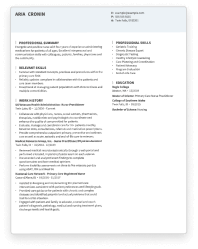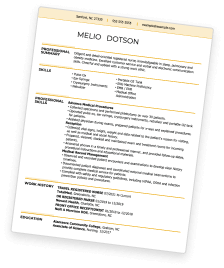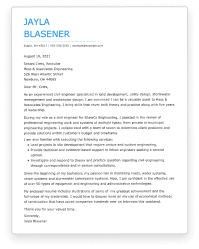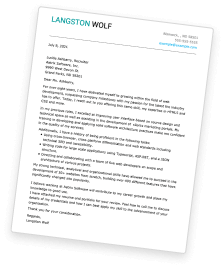Warehouse Worker Resume: Overview
As a warehouse worker, you are at the heart of the supply chain, ensuring the smooth operation of storage, inventory, and order fulfillment processes.
You play a vital role in ensuring that products reach their destinations on time, contributing significantly to customer satisfaction and the overall success of the business.
Your duties often encompass a range of tasks, including inventory management, packing and shipping orders, receiving and processing incoming stock, and operating machinery and vehicles.
This work can be found in various settings, such as:
- Distribution Centers
- Manufacturing Plants
- Retail Stockrooms
- Third-party Logistics Companies (3PLs)
- E-commerce Fulfillment Centers
Creating an outstanding resume is crucial for landing your next job as a warehouse worker, and our downloadable templates and exceptional examples are designed to assist you in showcasing your strengths and experiences effectively!
Warehouse Worker Resume: Choose A Format
Creating a standout warehouse worker resume starts with selecting the format.
It’s crucial to choose a resume format that highlights your strengths and qualifications in a compelling way, ensuring you catch the eye of potential employers.
Warehouse workers have three main resume formats to consider:
Chronological Resumes for Warehouse Workers
The chronological resume format is highly favored and is particularly effective for warehouse workers with a solid history of relevant work experience.
For instance, a candidate might detail their past positions in the work history section, including roles such as forklift operator, inventory clerk, or shipping and receiving assistant.
Each position should be described with a list of duties and accomplishments, alongside the job title, employer’s name, location, and dates of employment.
Bullet points describing responsibilities and achievements should employ strong action verbs and measurable results to make the resume more impactful and provide clear evidence of your capabilities.
Chronological resumes are also ATS-friendly (applicant tracking system), increasing the chances of your resume making it through the initial screening process.
Functional Resumes for Warehouse Workers
Functional resumes focus on the applicant’s skills rather than their work history.
This format is beneficial for those who may lack direct experience in warehouse work.
For example, a person transitioning from a different industry might use a functional resume to highlight transferable skills such as organizational abilities, physical stamina, and teamwork skills acquired from previous employment.
While functional resumes can help to showcase pertinent skills, it’s important to note that they are generally less favored by employers due to the emphasis on skills over direct experience and may not be as compatible with ATS.
Combination Resumes for Warehouse Workers
A combination resume blends the chronological and functional formats, offering equal weight to both skills and experience.
This format is advantageous for candidates looking to highlight both aspects effectively.
A warehouse worker might opt for a combination resume to equally showcase their physical capabilities, technical skills, and experience in inventory management, order picking, or machinery operation.
Choosing a Format
Selecting the appropriate resume format is a key step in the resume-writing process. It’s important to choose the format that best represents your qualifications and experiences.
When uncertain, the chronological format is typically recommended for its broad acceptance and ability to highlight professional experience.
However, if your work history is not directly related to warehouse work, consider identifying and including transferable skills from your previous roles that are relevant to warehouse operations.
Even non-warehouse jobs can demonstrate valuable skills such as teamwork, time management, and the ability to learn new processes quickly.
Reflect on your past experiences to identify how they can be applied to the role of a warehouse worker, enhancing your appeal as a candidate.
How To Write A Warehouse Worker Resume
Once you’ve selected a format for your warehouse worker resume, the next steps involve outlining the core sections of the document.
Every resume should consist of five essential sections, with the option to add more specialized sections depending on your background and the role you’re applying for.
The critical sections for a warehouse worker resume include:
- Contact Information
- Summary or Objective
- Work History
- Skills
- Education
Knowing how to write an effective resume is key to presenting yourself as a well-rounded candidate for warehouse positions, setting the stage for your career advancement.
Contact Information
Your contact information should prominently feature your full name, phone number, professional email address, and your current location (city and state).
If you have a LinkedIn profile or a digital portfolio showcasing your warehouse projects or certifications, you can include these as well, provided they add value to your application.
Position your contact information at the top of your resume, ensuring it’s easily noticeable but not overwhelming the rest of your content.
A typical contact information section for a warehouse worker might look like this:
John Doe
Houston, TX
john.doe@email.com
(555) 555-5555
Summary or Objective
Your resume should begin with a section right beneath your contact information that serves as a brief introduction to who you are as a professional.
This can be either a resume summary or an objective, depending on your experience and career goals.
A resume summary is ideal for warehouse workers who have a solid background in the field. It provides a quick overview of your key skills, relevant experiences, and professional achievements. This format is beneficial for showcasing a strong track record in warehouse operations.
An effective resume summary for a warehouse worker might be:
“Seasoned Warehouse Worker with over 10 years of experience in logistics, inventory management, and order processing. Demonstrated ability to improve operational efficiency and accuracy in fast-paced environments. Skilled in operating heavy machinery with a strong focus on safety and productivity. Proven track record in reducing processing times and improving customer satisfaction through meticulous organization and teamwork.”
A resume objective, on the other hand, is suited for those new to the warehouse industry or looking to make a career shift. It emphasizes your ambitions and how your skills and attributes make you a good fit for a warehouse position, despite a lack of direct experience.
A compelling resume objective for someone entering the warehouse sector might read:
“Enthusiastic and hardworking individual with a strong background in retail and customer service, aiming to transition into the warehouse industry. Brings a proven record of teamwork, punctuality, and a strong work ethic. Eager to apply organizational and physical skills to a dynamic warehouse environment, with a keen interest in developing proficiency in inventory software and logistics management.”
Note: Whether you choose a summary or an objective, this section is your chance to incorporate relevant keywords from the job description, ensuring your resume resonates with both ATS systems and hiring managers. Highlight your most pertinent skills and experiences here to encourage further reading of your resume.
Work History
The “Work History” section of your warehouse worker resume is crucial for illustrating your relevant experiences and skills. This section provides potential employers with concrete evidence of your abilities and showcases your achievements in previous roles.
Begin with your most recent job and list your experiences in reverse chronological order, focusing on positions most relevant to warehouse work.
This approach helps highlight your suitability for the warehouse worker role you’re applying for. Emphasize responsibilities and achievements that demonstrate your capabilities and fit for the job.
Employ strong action verbs and, when possible, quantify your accomplishments with numbers or percentages. Metrics add a layer of credibility to your achievements and help differentiate your resume by showing the specific value you brought to previous positions.
Here’s an example of what the work history section might look like for a warehouse worker resume:
Warehouse Associate
Logistics Solutions, Hometown, USA
06/2020 to Present
- Efficiently processed and packed an average of 250 orders daily, maintaining a 99% accuracy rate, significantly above the company average.
- Operated forklifts and pallet jacks to move stock across different warehouse sections, contributing to a 20% improvement in inventory management efficiency.
- Led a team of 5 warehouse staff in the implementation of a new inventory system, reducing stock discrepancies by 30%.
- Coordinated with the logistics department to optimize the packing and shipping process, resulting in a 15% reduction in processing time.
- Implemented safety protocols that led to a 25% decrease in workplace accidents, fostering a safer work environment.
Each bullet point should start with a strong action verb, clearly describing your role and impact within the company. By quantifying your contributions, you provide potential employers with a clear understanding of your capabilities and the tangible benefits you can bring to their operations.
Skills
Your resume should include a section dedicated to highlighting the skills most relevant to a warehouse worker position.
Like your work history, this section should focus on both hard skills and soft skills that demonstrate a well-rounded ability to perform in the role effectively.
When considering what skills to include, think about the technical and interpersonal abilities that showcase your qualifications for a warehouse job.
Here are some essential hard and soft skills for warehouse worker resumes:
Top 5 Hard Skills for Warehouse Worker Resumes
- Inventory Management: Proficiency in tracking and managing stock levels, orders, and deliveries is crucial for maintaining an efficient warehouse operation.
- Forklift Operation: Certification or experience in operating forklifts, pallet jacks, and other warehouse machinery is highly valued.
- Shipping and Receiving: Knowledge of shipping and receiving procedures, including packing, labeling, and using shipping software, is essential.
- Safety Protocols: Understanding and adherence to workplace safety standards and procedures to minimize the risk of accidents and injuries.
- Order Fulfillment: Experience in order picking, packing, and processing to ensure accurate and timely deliveries to customers.
Top 5 Soft Skills for Warehouse Worker Resumes
- Teamwork: Ability to work well with others to achieve common goals and maintain a productive warehouse environment.
- Communication: Effective communication skills are essential for coordinating with team members and management.
- Problem-solving: Capability to quickly identify and solve problems that arise in the warehouse operations.
- Attention to Detail: Keen attention to detail is vital for inventory management, order accuracy, and maintaining safety standards.
- Time Management: Efficiently managing one’s time to meet deadlines and prioritize tasks in a fast-paced setting.
In your resume, the skills section for a warehouse worker might look like this:
Skills
- Inventory Management: Skilled in utilizing inventory software for accurate stock tracking.
- Forklift Operation: Certified Forklift Operator with extensive experience in safe machinery handling.
- Safety Protocols: Proficient in implementing and adhering to safety guidelines and procedures.
- Teamwork & Communication: Effective collaborator known for excellent communication skills.
- Problem-solving & Time Management: Adept at addressing operational challenges and prioritizing tasks.
This section should be concise yet informative, providing a snapshot of your capabilities that are most relevant to the job you’re applying for.
Education
While warehouse positions may vary in their education requirements, highlighting relevant education, training, or certifications can set you apart from other candidates.
The education section of your warehouse worker resume should detail your highest level of education, including the name of the institution, its location, and your degree or certification.
Here’s an example of what the education section might look like for a warehouse worker:
Western Technical College
Houston, TX
Associate of Applied Science in Logistics and Supply Chain Management
Additional Sections
Consider adding extra sections to your warehouse worker resume if they provide value and highlight relevant skills or achievements.
These sections can differentiate you from other candidates by showcasing a more comprehensive view of your qualifications and interests.
For a warehouse worker, additional sections could include:
- Certifications: List any certifications relevant to warehouse work, including safety certifications, machinery operation licenses, or logistics certifications.
- Volunteer Experience: Share any volunteer experiences that demonstrate transferable skills such as teamwork, leadership, or problem-solving.
- Professional Associations: Membership in professional associations related to logistics, supply chain management, or related fields can show your commitment to staying current in the industry.
- Awards and Honors: Highlight any awards or recognitions received that are relevant to your professional work or skills.
- Relevant Hobbies: Mention hobbies that demonstrate qualities important to warehouse work, such as model-building (attention to detail), team sports (teamwork), or DIY projects (problem-solving and physical dexterity).
Adding these sections should be strategic, ensuring that they enhance your resume’s impact without detracting from your core qualifications. Choose to include extras that are most relevant to the job you’re applying for and that best showcase your strengths as a candidate.
Top Certifications For Warehouse Workers
Certifications can significantly enhance a warehouse worker’s resume by validating their skills and knowledge in specific areas of warehouse operations.
While not all warehouse positions require certifications, having them can make you a more competitive candidate, especially for roles that involve specialized equipment or advanced logistical tasks.
Here are some real-life certifications that are valuable for warehouse workers:
- Forklift Operation Certification: One of the most essential certifications for warehouse workers, this certification demonstrates proficiency in operating forklifts safely and efficiently. It’s often required for positions that involve moving and stacking goods.
- OSHA Safety Certification: The Occupational Safety and Health Administration (OSHA) offers various certifications related to workplace safety. For warehouse workers, completing OSHA safety training can showcase a commitment to maintaining a safe working environment.
- Certified Logistics Associate (CLA): Offered by the Manufacturing Skill Standards Council (MSSC), the CLA certification covers the core competencies of logistics operations, including safety, quality control, and supply chain basics.
- Certified Logistics Technician (CLT): Also provided by the MSSC, this certification builds on the CLA and delves deeper into logistics operations. It’s designed for individuals who want to demonstrate advanced knowledge in logistics technology, warehouse inventory, and supply chain management.
- APICS Certified in Production and Inventory Management (CPIM): Offered by the Association for Supply Chain Management (APICS), the CPIM certification is geared towards individuals seeking to validate their expertise in production and inventory management, a key component of warehouse operations.
8 Tips For Writing A Warehouse Worker Resume
Tailor Your Resume: Adapt your resume for each job application to reflect the specific requirements and skills highlighted in the job posting. Matching the language and keywords of the posting can increase your chances of getting noticed.
Use Action Verbs: Describe your warehouse duties and achievements using strong action verbs like “coordinated”, “managed”, “implemented”, or “optimized”. This makes your resume more dynamic and impactful.
Quantify Achievements: Whenever possible, use numbers and percentages to detail your accomplishments. For instance, mention how you increased inventory accuracy or decreased order processing time. Quantifiable achievements offer concrete evidence of your value to past employers.
Incorporate Keywords: Include keywords related to warehouse work from the job description in your resume. This strategy helps your resume pass applicant tracking systems (ATS) and shows that you have the specific skills employers are looking for.
Highlight Safety Practices: Emphasize your knowledge and implementation of safety protocols and certifications. A strong commitment to safety is a critical competency in warehouse operations.
Mention Equipment Proficiency: Detail your experience with warehouse equipment, such as forklifts, pallet jacks, and inventory management systems. Being certified to operate machinery or use specific software can set you apart from other candidates.
Showcase Soft Skills: While technical skills are essential, don’t forget to highlight your soft skills, such as teamwork, communication, and problem-solving abilities. These skills are crucial for coordinating with team members and ensuring efficient operations.
Proofread for Professionalism: A well-written, error-free resume reflects your professionalism and attention to detail. Ensure your resume is free from spelling and grammatical errors to make a strong first impression.
View Similar Resume Examples


Use Hloom's Resume Builder
Key Takeaways
- Tailoring your warehouse worker resume to fit the specific job you’re applying for can significantly increase your chances of landing the job.
- Choosing the appropriate format for your resume, such as the chronological format, allows you to effectively showcase your work history and skills.
- Including relevant certifications and education not only validates your qualifications but also sets you apart from other candidates.
- Employers look for candidates with a balance of technical and interpersonal skills. Be sure to list both hard skills, such as inventory management and equipment operation, and soft skills, like teamwork and problem-solving.
- Making your resume ATS-friendly by including relevant keywords and phrases from the job description ensures it gets seen by human eyes.
Use Hloom's Cover Letter Builder














